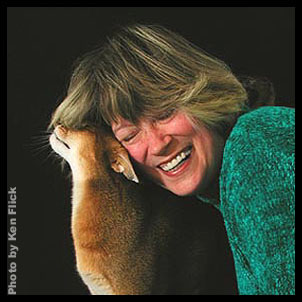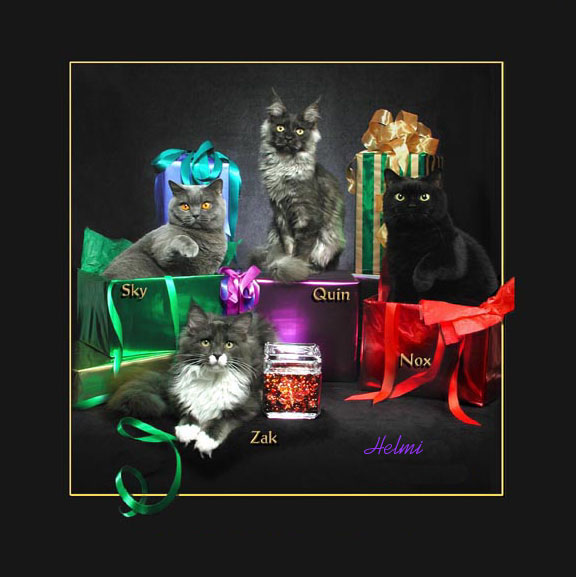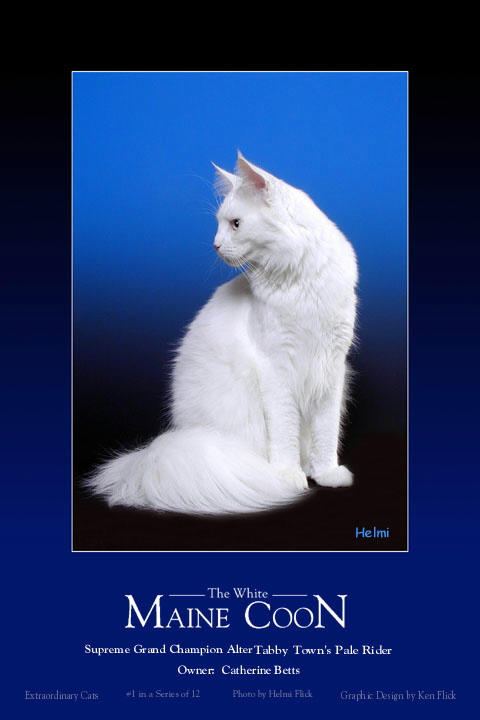This article is Copyright 2006, James Morrissey, and may
not, in part or in whole, be reproduced in any electronic or printed medium without prior permission from the author. The images in this article are the property of Helmi Flick and have been licensed to James Morrissey and the NWP Photo Forum for the purpose of this interview.
Part I: About Helmi Flick

Copyright Helmi Flick
JM: Can you tell us a little about what life was like when you were growing up?
HF: I am half-Finnish from my father. That’s where my name, Helmi, comes from. I was born in Grass Valley, California, in 1945. My father, Paul Kivisto, was a Clinical Psychologist and my mother, Beth, a Librarian. I have a younger sister, Paula. Cats have almost always been a part of my family. Through grammar school, I lived in central California, much of that time on the coastline in Cayucos, a small town north of Morro Bay. Those years were the beginning of my lifelong love of the ocean.
When I was 12 years old, we moved to Shreveport, Louisiana. It was interim culture shock born of a temporary language barrier until I learned to understand “Southern.” College, where I majored in Art, and the first years of my first marriage were spent in northern Louisiana, where I put my husband, Larry Haines, through pharmacy school. When he graduated, we moved to New Orleans, living in the University District. I worked at both Tulane Medical Center and Loyola Law School in an administrative support capacity in Biostatistics and Law, respectively.
We moved to the Los Angeles area in 1978. I worked for Childrens Hospital Los Angeles for 14 years, again in administrative support, in various departments from Neonatology to Neuropathology. A milestone in my life was when, in 1990, I finally decided to give up on a marriage that I had spent far too many years trying to fix. I got my own apartment, close to work, and reveled in my independence! A couple of years later, I reconnected with an old friend, Ken Flick, who had lived in Los Angeles but had moved to Dallas, Texas, a few years earlier. What had long been a close friendship with many mutual interests evolved into something deeper and became a long distance relationship. Ken, then in his early 50s, had never been married. I’d like to think he was waiting for me, but for all of his attractions, I had serious reservations about his qualifications as a potential life partner. However, when he told me that a stray cat, “Miss Kitty,” had adopted him and moved into his life, I decided to take him up on his invitation to fly out and visit him in Dallas.
In late 1993, after more than a year of a long distance relationship and several visits back and forth, he persuaded me (he’s good at that) to come live with him in Texas. It wasn’t for the scenery or the weather, I can assure you.
In 1998, we got married barefoot on the beach in Florida. We rented a beach house and invited a number of old friends to be with us and participate in a weeklong wedding feast. What a time!
A month before our wedding, we had bought a house in Bedford, Texas, a community between Dallas and Fort Worth, where we still live today with our four cats.
JM: Do you have a family of your own?
HF: I have no children but cats always filled that role for me.
JM: When and how did you first begin to photograph?
HF: My first camera was my mother’s Brownie, which I learned to use and took on a class train trip to New Orleans from Shreveport in the 6th grade. I remember taking pictures of the flamingos at the Zoo. How that little box could produce an image to capture a moment in time was an intriguing technology I didn’t understand. It was pure magic to me. This has proven to be a recurring theme in my largely non-technical relationship with photography.
I would like to say that that experience began a life long love of photography but the truth is I probably didn’t take ten rolls of pictures between that trip in 1958 and the early 1980s. That was when Ken (who at that time was a close friend of the family) gave Larry and I an Olympus OM-2, my first “real” camera. My favorite lens was a 28mm-85mm macro. I loved shooting flowers and landscapes. On weekends, I enjoyed going on photo shoots with Ken and Larry along the California coast, in the desert, and in the San Gabriel Mountains of Angeles National Forest.
JM: What formats (e.g. Medium, digital, 35mm, etc)? do you use for your current work?
HF: I am a digital photographer. I began my current career with a digital camera and have never used film. I cannot imagine shooting cats with film. My hat is off to those who made their living in this niche business in the years before digital was an option. I currently shoot with a Canon EOS 20D and use a Tamron f2.8 28-75mm lens exclusively.
I started this career with a 2MP Olympus C-2020Z in May of 2000 and stayed with the Olympus C-Series of point-and-shoot cameras throughout its evolution through 3- ,5-, and 8-megapixels. In the beginning, digital SLRs were horrendously expensive and simply not an option for my limited equipment budget.
In a way I was smugly proud of being able to do publishable work -- including several national magazine covers -- with these simple, affordable, consumer cameras, despite the considerable handicap of shutter lag when shooting an active subject, like cats.
Ken, who is my cat wrangler among many other things, would coax the cat into the perfect pose, step aside and wait for me to shoot. All too often that wait would be protracted and eventually Ken would say, with no little sarcasm, “NOW would be a good time!” And I, who had long since done my pre-focusing, and was squeezing the shutter button to no avail, would growl through gritted teeth, “I’m pressing! I’m pressing!” This interminable lag which perversely seemed to reach new levels of intolerability with the Olympus C-8080, combined with the eventual affordability of entry level DSLRs, was what moved me to the Canon 20D. Since then, the ability to take the shot immediately whenever the fleeting photo opportunities of cat photography present themselves was, and is, a joy.
JM: Photographic education?
HF: None.
JM: Photography is not a first career for you. Can you tell me how you got to where you are at today.
HF: For the first 25+ years of my working life before I began this career, I gave my best effort as an administrative assistant, medical secretary, legal secretary, executive secretary to a succession of bosses in a variety of fields. I approached each of these positions with the same dedication as I did throughout my first marriage. Yet, at work, much like at home in those days, there was just not the sense of personal fulfillment that I felt should be possible. There had to be something more.
After moving to Dallas, I told Ken I would go to work when I got tired of being at home with him and our kitties. Although that never happened, when I got a call from a friend for a temporary position, I took it.
I went to work for a company that supplied businesses with PCs and networking equipment and they soon made me an attractive offer of full time employment. They called themselves a “value-added reseller.” It was insufferable corporate jargon such as this, along with the blight of political correctness and evaporating sense of loyalty that companies used to have for their employees that fueled my growing disaffection with “working for the man.” Living in a Dilbert cartoon was not nearly as amusing as reading them, so I downsized myself before my attitude eroded my work ethic.
I was primed for a livelihood I could feel passionately about.

Copyright Helmi Flick
Like so many people, I was living two lives: one I dearly loved at home with Ken and the cats, and the other one that subsidized the one I loved. Like so much of the corporate workforce, I was living for evenings and weekends.
One of the delights of my home life was our cats -- the two British Shorthairs, Sky and Nox, whom we got when Miss Kitty died, and Bwana Bushwah, a first generation Chausie (a Chausie is an exotic hybrid, the half wild offspring of a domestic cat and a Jungle Cat – felis chaus).
I could spend hours just watching them, whether in agile antics or graceful repose. Beyond the joys of just observing these cats at play, I became intrigued with photographing them in an attempt to express and share in print the joy I got from observing these magnificent creatures. At the time, my tool for doing this was a little Olympus Stylus snapshot film camera. And I became prodigious in my consumption of film. Maybe profligate would be more accurate, since my boundless enthusiasm for this pursuit was in no way matched by my skill in producing aesthetically pleasing or even technically correct images.
Anyone who has ever photographed their own cats knows that this is typically an elusive exercise with a very low yield of satisfying results, and my early efforts were no exception. The cat’s participation in the process ranges from oblivious to outright contrariness and timing is everything. The cat is going to do only what it wants to do, but if you have Zen-like patience and cat-like reflexes, there may be a brief moment, if you’re lucky, when the cat’s pose or behavior coincides with what you want from it. In those early days, when I would pick up my prints from the photo lab and sort through the stack with great anticipation, the overwhelming percentage of the shots fell into the unlucky pile.
Digital Photography to the Rescue
In the spring of 1999, in an effort to reduce the expenses of my hobby, Ken got me a digital camera for his birthday, a 1.3MP Fuji MX-600Zoom. That changed everything for me. Compared to film-based cameras, the digital camera is an astonishingly effective learning tool that rapidly improved my picture taking skills. The instant feedback of digital enabled me to immediately see my shot, note what I did wrong or could have done better, and then retake the shot while the photo opportunity still existed. I also learned faster because, without the expense of film, I was free to take an unlimited number of pictures and thus acquired more experience faster. I took full advantage of this fast-track learning curve that digital photography enabled.
At the same time, I started fooling around with Adobe Photo Deluxe, the simple little image-editing program that came with my Fuji. I found that even my best images could be improved with a little tweaking and soon discovered that I enjoyed this PC-based part of the process almost as much as capturing the original image.
JM: What is it that gave you the confidence to go pro?
HF: In the year that followed my move from film to digital, my work improved steadily. Ken encouraged my transition into serious cat portraiture by building me a formal shooting stage and equipping me with studio lighting gear. As well as shooting our own cats, I started shooting those of some local breeder friends whom we met at cat shows where we had exhibited our kitties, and thus began building a small portfolio of my work.
By the spring of 2000, based on the reception that my photos were getting from acquaintances in the cat fancy and from fellow members of a online feline photo sharing site Ken started, I was encouraged to "go pro." I received an introduction from a friend to the Show Manager of a cat club in Oklahoma City and I followed up by sending a selection of my best cat images to her. She responded by inviting me to be the Show Photographer for the TICA Thunderkatz Show in Oklahoma City in May of 2000.
Maybe I didn’t know enough to be appropriately apprehensive, but I just jumped into it with great enthusiasm and never stopped to reflect on what might go wrong. Ken was with me to do my lighting and cat wrangling, my sister, Paula, flew up from New Orleans to show our cats and lend moral support, and I was surrounded by friends I had made online. Plus, this was my first opportunity to shoot more cats than I could imagine. I was so pumped that fear wasn’t a component of the experience back then, and this “no fear” approach that I seem to be blessed with has held true ever since. There always seems to be inevitable problems, be it technical or logistical, that crop up at each cat show. Yet I tend to view these as puzzles to be solved in the most expedient way possible – they become challenges that make each show an adventure. That first cat show certainly had its share of fiascoes and faux pas.
And while I certainly can’t claim to be pleased with every cat photo I’ve taken since then, I am amazed that the very first cat I shot at my very first show produced a portrait that I can still be proud of today.

Copyright Helmi Flick
JM: Who do you credit as your largest photographic influences?
HF: Ken Flick was a big influence, then and now. I learned from him what I knew at the time of the nuts and bolts of photography when we would go on field trips. Ken owned an audio-visual production company in Hollywood. He wrote and produced corporate multi-projector, multi-screen, slide shows in the 80s. Often our photo trips were to gather images for some of these projects. The ones involving nature photography were of particular interest to me. He has taught me the technical aspects of photography (which I regard as a necessary evil). He is my best friend and biggest supporter. He is also my roadie, lighting guy, technical advisor, cat wrangler and business manager. Ken critiques my work, even when I least want it, and boosts my spirits when I most need it.
There are two cat photographers who I consider to be the “Big Guys” in my field: Richard Katris, who goes by the name of “Chanan” and Tetsu Yamazaki. Both Richard and Tetsu have been photographing cats for more than 20 years. Well before the dawn of digital. And it was their ability to get great images with film that most impressed me.
After admiring their work in print for the first five years of my career, I had an opportunity to meet Richard and Tetsu in person, where both were the Show Photographers at the big CFA International Cat Show in Houston. When I introduced myself to Richard Katris, as Helmi Flick, he shook my hand, grinned, and said, “So you’re Helmi. I thought about putting out a contract on you!” Tetsu, apropos of his culture, was gracious and more restrained, but I was very pleased that he knew who I was.
My work had been published in books and magazines for a while, by the time I introduced myself these icons of cat photography – which was the main reason I felt comfortable in doing so. But it was those moments of being greeted as a peer that I counted as a milestone in my career, right up there with my first magazine cover.
I did not have a mentor-protegee relationship with either of these gentlemen. I simply aspired to do work at their level. Beyond that, everything I know about photographing cats is pretty much self-taught. From the beginning, I tried to do work that pleased my customers, the breeders and owners of my feline subjects. And because I was shooting digital from the beginning (and perhaps before anyone else in this business), I was able to review each photo session with my customers and learn from this process. I discovered from them what kinds of poses worked for cats in general as well as which poses showed off each specific breed of cat to its best advantage.
Beyond this, I cannot say that I was an ardent observer of the photographic craft, nor was I particularly influenced or inspired by the work of any specific photographer. My background in fine art and commercial art was more influential in shaping my interest in visual media. Graphic art, painting and architecture intrigued me more at that time than photography.
Once again, it would make a good story to say that my time with the Olympus OM-2 marked the beginning of what would be my eventual career, but when my marriage to Larry ended, it was no great loss that the camera went with him. It would be years before the real origins of my photography began – right in my own home.
JM: What motivates you in the work that you do?
HF: My love of cats. My goal as a cat photographer is to create portraits that showcase the best qualities of each of my subjects. These are magnificent creatures and I believe that each one of them deserves to be admired and remembered.
You can view more of Helmi Flick's work at
http://www.webphotoforum.com/artist.asp?aID=1677 You can also visit her home page at
http://www.helmiflick.com/